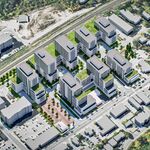What are you proposing for Yonge, exactly? A streetcar ROW? From where to where?
There is generally an over supply of vehicle space on part of Yonge, but I think it's critical the excess is allocated to pedestrians first. The sidewalk space on Yonge is tiny. Cul-de-sac's in Scarborough have wider sidewalks.
The sidewalks on Spadina Ave. actually had to be cut back and narrowed in order to put in the then dubbed Spadina LRT ROW. The sidewalks get especially narrow near Wellington and Front St. and with CityPlace built, it does make the sidewalk less hospitable with a more or less Spadina Expressway-esque street enviroment with the street's six lanes of car traffic.
I don't know how seriously an LRT on Yonge would be taken, but when I try riding the subway northbound around 3-6 pm, it can get completely packed. Since the line was never built with two sets of tracks for express and local, a surface level pressure relief LRT line could work, with a centre ROW with half of the side lanes for wider sidewalks and the other half for bike lanes. I could see it running from Union Station to Eglinton, perhaps as a continuation of the Bay st. streetcar tunnel and emerge where feasable.
Turning more downtown streets over to Streetcars, bicycles and pedestrians is the only way. I also see how gridlocked it is on say King St is and it is obvious what needs to be done. With the purchase of new automobiles on a steady decline in Canada since 2002 and some new condo towers like the new RCMI tower at University and Dundas not even having any underground parking, it is obvious that more people are coming downtown not expecting to use their cars. It will be for sure a major upheaval of a decision to start pushing cars out of the city, but gradually it will come. And with more light rail in the inner suburbs and 905, more dense downtown living will come to more areas, and it will probably build momentum and accelerate at a further rapid rate as we head closer to 2050. Obviously some of the LRT/Streetcar ROW planning of the 1980s demanded tunnelling the ROW where necessary, but even when I look at the St. Clair ROW by the CN Weston Sub., the street has only one open lane of traffic each way, so obviously there is already a willingness by the city to start pushing out the automobile.
I also look to the very original plans for rapid transit in this city from the 1910s, that would have called for funnelling the city streetcar lines into underground streetcar lines along Yonge and Queen St. An artist rendering for the Yonge St underground streetcar line would have also had parallel surface level streetcar service on top. Pull up a copy of Mike Filey's Not A One Horse Town book and one of the pages has the illustration. Quite an interesting system that would have been, a whole web of streetcar service funnelling into the downtown, thus what would have made Toronto a streetcar only city with streetcars everywhere, which I am sure would have never allowed a Streetcars vs Subways spat that this city witnessed around the late 1970s/early 1980s and more recently. It probably also would have blocked this city from ever being given the ICTS SRT, which I am sure deepened Scarborough's feelings about how the city treated them. Of course the originally planned Scarborough LRT from the 1970s would have had no issues, whereas the SRT's ICTS magnetic propulsion rail wouldn't work with snow and ice covering it in the winter time even to the present time...





